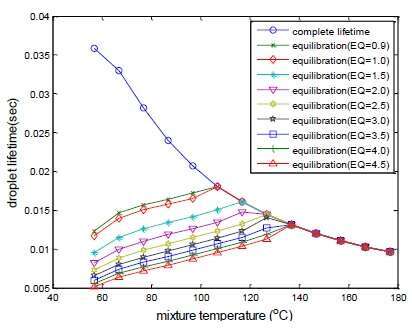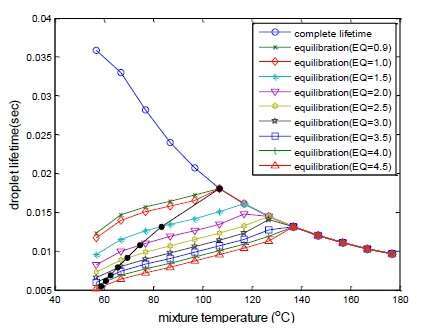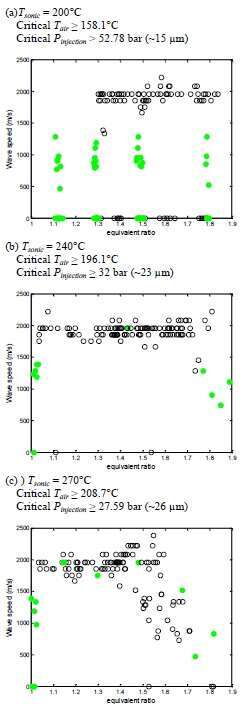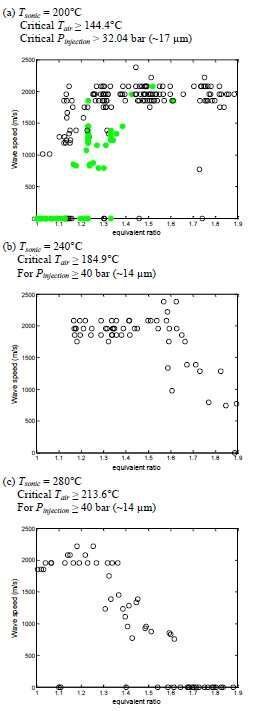Introduction
In the present study, experiments on liquid-fuel air-breathing pulse detonation engines (PDE) are conducted using a low-vapor-pressure fuel: Jet A-1. Past studies have mostly focused on demonstrating the use of high-vapor-pressure fuels (e.g. heptane) or low-vapor-pressure fuels (e.g. JP8 and Jet A-1) with a predetermined air temperature (e.g. 398 K) or with some pre-treatments on the liquid fuels (e.g. preheating of fuel). Based on previous notable studies [1-3], critical conditions for success or failure of liquid-fuel PDEs are mainly related to fuel types, inlet air temperatures and spray droplet sizes. Essentially, these conditions determine the amount of pre-vaporized fuel prior to ignition. The present paper attempts to establish a criterion for detonation transition of two-phase Jet A-1/air mixtures.
In a liquid-fuel PDE, the long tube required to achieve detonation via deflagration-to-detonation transition process makes it advantageous for the allowable filling time tf to induce more vaporization of the incoming spray droplets, so as to promote sufficient fuel to exist in the vapor phase for detonation transition. Assuming a situation where sufficient pre-vaporized fuel is present; the data for droplet equilibration lifetime te can provide a threshold for the allowable filling time tf of a PDE. For the case of tf « te, it is impossible to achieve detonation within the PDE tube. When these two time scales are comparable, there would be a critical ratio of these two characteristic times identifying the success or failure of detonation transition. Note that the calculation of te is based on mono-dispersed droplet diameters, see next paragraph. In reality, the spray has poly-dispersed droplet diameters ranging from 2.25 to 300 μm from droplet distribution measurements. In the present study, to simplify this problem, the statistical Sauter Mean Diameter (SMD) representing the mean diameter of spray droplet distribution is applied to establish the criterion of tf/te for detonation transition of two-phase mixtures, based on experimental results.
Droplet equilibration lifetime
Applying the known vapor-phase fraction of a two-phase mixture in equilibrium at a specific temperature, which is computed using SUPERTRAPP, we can estimate te during which the droplet undergoes vaporization following the D-squared (D2) Law. However, this process ceases when the vaporized fuel amount is identical to that at the phase equilibrium state. Equation (1) can be used to compute :
te = d02(1-(1-Xv)2/3)/β (1)
where: Xv = fraction of vaporized fuel at phase equilibrium state
d0 = initial droplet diameter
β = evaporation coefficient
Figure 1 shows the computed values of te for different mixture compositions (EQ = 0.9-4.5) with d0 = 25 µm SMD. For lower mixture temperatures, te is shorter than the complete lifetime until a higher temperature is reached where the liquid fuel has fully vaporized. For the case of a more fuel rich mixture, te can be further decreased. However, a shorter equilibration time principally indicates a two-phase mixture attaining phase equilibrium within a shorter time duration. It does not mean that sufficient vaporized fuel will be generated for detonation transition. For example, at Tair = 57°C, for d0 = 25 µm and EQ =1, te is 0.012 sec, but its vapor-phase equivalence ratio (EQv) is 0.45, which would be too lean for the onset of detonation. Figure 2 shows the required te for the vapor-phase composition of a two-phase mixture to achieve stoichiometric conditions, marked by (●). The te to attain EQv = 1.0 decreases as an increasingly fuel-rich mixture is employed. This implies that it is possible to achieve detonation transition even for relatively low mixture temperatures.
Criterion for detonation transition
Figure 3 presents experimental results of the critical conditions for three controlled inlet air temperatures. The filled circles in green correspond to unsuccessful detonation transition caused by the lower injection pressure or the lower inlet air temperature than their critical values. The critical ratio tf/te for detonation transition is 32, 17.1 and 14.1 corresponding to mixture temperatures of 158.1, 196.1 and 208.7°C, respectively. This indicates that the critical tf/te ratio depends on the mixture temperature. With a lower mixture temperature, in order to attain successful detonation transition, a longer filling time relative to the droplet equilibration lifetime is required. Figure 4 presents the results for the cases using heated Jet A-1 (100°C). At the mixture temperature of 144.4°C, the critical tf/te is 32.1, which is consistent with the case for unheated Jet A-1. Actually, the use of heated Jet A-1 causes a decrease in the droplet lifetime by 22.4% and in the SMD diameter by 25%. This consistency between the cases of unheated and heated Jet A-1 validates the criterion of tf/te for liquid-fuel PDE.
From experimental results, the DDT run-up distance for Jet A-1/air mixture is around 40 times of the cellular width λ. A semi-empirical equation for this criterion can be expressed as follows:
λ/Vair ≥ constant × d02(1-(1-Xv)2/3)/β (2)
where: λ, β, Xv = f(T,P)
This semi-empirical equation may be employed for determining the critical parameters corresponding to design operating conditions, and it also serves as a good tool for the design of a flight-weight liquid-fuel PDE.
Reference
[1] Brophy, C.M., Netzer, D.W., Sinibaldi, J., Johnson, R., Book: High-Speed Deflagration and Detonation, pp. 207-222, 2001.
[2] Tucker, K.C., King, P.I., Schauer, F.R., Journal of Propulsion and Power, Vol. 24, No. 4, pp. 788-796, 2008.
[3] Frolov, S.M., Journal of Propulsion and Power, Vol. 22, No.6, pp. 1162-1169, 2006.





